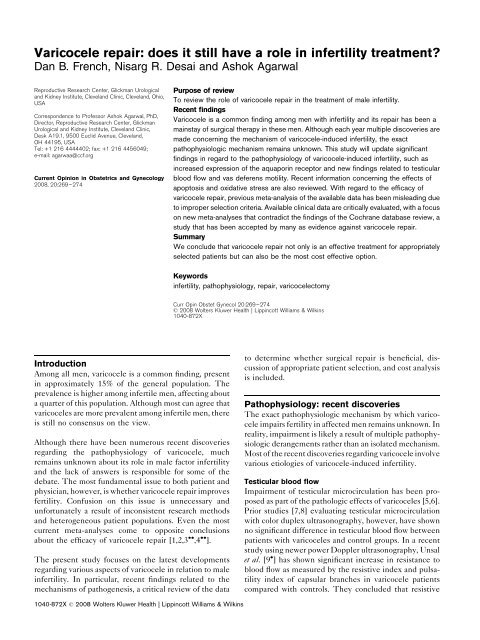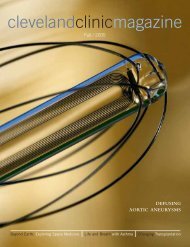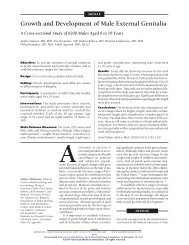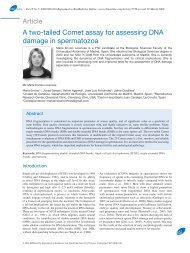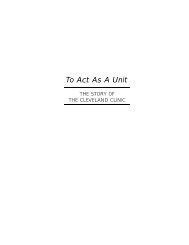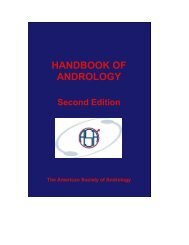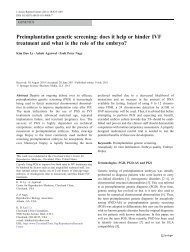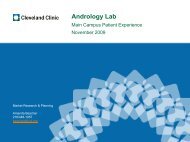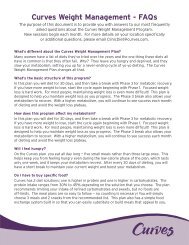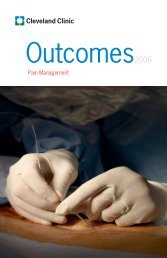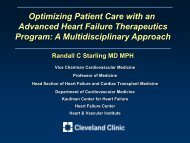Varicocele repair: does it still have a role in infertility treatment?
Varicocele repair: does it still have a role in infertility treatment?
Varicocele repair: does it still have a role in infertility treatment?
You also want an ePaper? Increase the reach of your titles
YUMPU automatically turns print PDFs into web optimized ePapers that Google loves.
<strong>Varicocele</strong> <strong>repair</strong>: <strong>does</strong> <strong>it</strong> <strong>still</strong> <strong>have</strong> a <strong>role</strong> <strong>in</strong> <strong>in</strong>fertil<strong>it</strong>y <strong>treatment</strong>?Dan B. French, Nisarg R. Desai and Ashok AgarwalReproductive Research Center, Glickman Urologicaland Kidney Inst<strong>it</strong>ute, Cleveland Cl<strong>in</strong>ic, Cleveland, Ohio,USACorrespondence to Professor Ashok Agarwal, PhD,Director, Reproductive Research Center, GlickmanUrological and Kidney Inst<strong>it</strong>ute, Cleveland Cl<strong>in</strong>ic,Desk A19.1, 9500 Euclid Avenue, Cleveland,OH 44195, USATel: +1 216 4444402; fax: +1 216 4456049;e-mail: agarwaa@ccf.orgCurrent Op<strong>in</strong>ion <strong>in</strong> Obstetrics and Gynecology2008, 20:269–274Purpose of reviewTo review the <strong>role</strong> of varicocele <strong>repair</strong> <strong>in</strong> the <strong>treatment</strong> of male <strong>in</strong>fertil<strong>it</strong>y.Recent f<strong>in</strong>d<strong>in</strong>gs<strong>Varicocele</strong> is a common f<strong>in</strong>d<strong>in</strong>g among men w<strong>it</strong>h <strong>in</strong>fertil<strong>it</strong>y and <strong>it</strong>s <strong>repair</strong> has been ama<strong>in</strong>stay of surgical therapy <strong>in</strong> these men. Although each year multiple discoveries aremade concern<strong>in</strong>g the mechanism of varicocele-<strong>in</strong>duced <strong>in</strong>fertil<strong>it</strong>y, the exactpathophysiologic mechanism rema<strong>in</strong>s unknown. This study will update significantf<strong>in</strong>d<strong>in</strong>gs <strong>in</strong> regard to the pathophysiology of varicocele-<strong>in</strong>duced <strong>in</strong>fertil<strong>it</strong>y, such as<strong>in</strong>creased expression of the aquapor<strong>in</strong> receptor and new f<strong>in</strong>d<strong>in</strong>gs related to testicularblood flow and vas deferens motil<strong>it</strong>y. Recent <strong>in</strong>formation concern<strong>in</strong>g the effects ofapoptosis and oxidative stress are also reviewed. W<strong>it</strong>h regard to the efficacy ofvaricocele <strong>repair</strong>, previous meta-analysis of the available data has been mislead<strong>in</strong>g dueto improper selection cr<strong>it</strong>eria. Available cl<strong>in</strong>ical data are cr<strong>it</strong>ically evaluated, w<strong>it</strong>h a focuson new meta-analyses that contradict the f<strong>in</strong>d<strong>in</strong>gs of the Cochrane database review, astudy that has been accepted by many as evidence aga<strong>in</strong>st varicocele <strong>repair</strong>.SummaryWe conclude that varicocele <strong>repair</strong> not only is an effective <strong>treatment</strong> for appropriatelyselected patients but can also be the most cost effective option.Keywords<strong>in</strong>fertil<strong>it</strong>y, pathophysiology, <strong>repair</strong>, varicocelectomyCurr Op<strong>in</strong> Obstet Gynecol 20:269–274ß 2008 Wolters Kluwer Health | Lipp<strong>in</strong>cott Williams & Wilk<strong>in</strong>s1040-872XIntroductionAmong all men, varicocele is a common f<strong>in</strong>d<strong>in</strong>g, present<strong>in</strong> approximately 15% of the general population. Theprevalence is higher among <strong>in</strong>fertile men, affect<strong>in</strong>g abouta quarter of this population. Although most can agree thatvaricoceles are more prevalent among <strong>in</strong>fertile men, thereis <strong>still</strong> no consensus on the view.Although there <strong>have</strong> been numerous recent discoveriesregard<strong>in</strong>g the pathophysiology of varicocele, muchrema<strong>in</strong>s unknown about <strong>it</strong>s <strong>role</strong> <strong>in</strong> male factor <strong>in</strong>fertil<strong>it</strong>yand the lack of answers is responsible for some of thedebate. The most fundamental issue to both patient andphysician, however, is whether varicocele <strong>repair</strong> improvesfertil<strong>it</strong>y. Confusion on this issue is unnecessary andunfortunately a result of <strong>in</strong>consistent research methodsand heterogeneous patient populations. Even the mostcurrent meta-analyses come to oppos<strong>it</strong>e conclusionsabout the efficacy of varicocele <strong>repair</strong> [1,2,3 ,4 ].The present study focuses on the latest developmentsregard<strong>in</strong>g various aspects of varicocele <strong>in</strong> relation to male<strong>in</strong>fertil<strong>it</strong>y. In particular, recent f<strong>in</strong>d<strong>in</strong>gs related to themechanisms of pathogenesis, a cr<strong>it</strong>ical review of the datato determ<strong>in</strong>e whether surgical <strong>repair</strong> is beneficial, discussionof appropriate patient selection, and cost analysisis <strong>in</strong>cluded.Pathophysiology: recent discoveriesThe exact pathophysiologic mechanism by which varicoceleimpairs fertil<strong>it</strong>y <strong>in</strong> affected men rema<strong>in</strong>s unknown. Inreal<strong>it</strong>y, impairment is likely a result of multiple pathophysiologicderangements rather than an isolated mechanism.Most of the recent discoveries regard<strong>in</strong>g varicocele <strong>in</strong>volvevarious etiologies of varicocele-<strong>in</strong>duced <strong>in</strong>fertil<strong>it</strong>y.Testicular blood flowImpairment of testicular microcirculation has been proposedas part of the pathologic effects of varicoceles [5,6].Prior studies [7,8] evaluat<strong>in</strong>g testicular microcirculationw<strong>it</strong>h color duplex ultrasonography, however, <strong>have</strong> shownno significant difference <strong>in</strong> testicular blood flow betweenpatients w<strong>it</strong>h varicoceles and control groups. In a recentstudy us<strong>in</strong>g newer power Doppler ultrasonography, Unsalet al. [9 ] has shown significant <strong>in</strong>crease <strong>in</strong> resistance toblood flow as measured by the resistive <strong>in</strong>dex and pulsatil<strong>it</strong>y<strong>in</strong>dex of capsular branches <strong>in</strong> varicocele patientscompared w<strong>it</strong>h controls. They concluded that resistive1040-872X ß 2008 Wolters Kluwer Health | Lipp<strong>in</strong>cott Williams & Wilk<strong>in</strong>s
270 Fertil<strong>it</strong>y<strong>in</strong>dex and pulsatil<strong>it</strong>y <strong>in</strong>dex are more reliable parametersto assess alterations <strong>in</strong> <strong>in</strong>tratesticular blood flow. Theyalso noted the <strong>in</strong>creased sens<strong>it</strong>iv<strong>it</strong>y of power Dopplerultrasonography over color duplex ultrasonography todetect slow flow and show organ perfusion and thusconcluded that the <strong>in</strong>creased resistive <strong>in</strong>dex and pulsatil<strong>it</strong>y<strong>in</strong>dex of capsular branches <strong>in</strong>dicates impairedmicrocirculation <strong>in</strong> patients w<strong>it</strong>h cl<strong>in</strong>ical varicocele.Oxidative stress and total antioxidant capac<strong>it</strong>yAnother well known pathophysiologic derangement <strong>in</strong>patients w<strong>it</strong>h varicocele is elevated reactive oxygenspecies (ROS) <strong>in</strong> semen samples of both fertile and <strong>in</strong>fertilemen w<strong>it</strong>h varicocele [10,11]. In relation to elevatedROS levels, varicocele is also associated w<strong>it</strong>h decreasedabil<strong>it</strong>y to resist oxidative stress as measured by the levels oftotal antioxidant capac<strong>it</strong>y [11]. More recently, Nallella et al.[12] not only confirmed that patients w<strong>it</strong>h varicocele<strong>have</strong> elevated ROS levels and decreased total antioxidantcapac<strong>it</strong>y but also described elevated levels of thepro-<strong>in</strong>flammatory cytok<strong>in</strong>e IL-6 <strong>in</strong> these patients andassociated <strong>it</strong> w<strong>it</strong>h the elevated ROS levels.Other pathologic changes associated w<strong>it</strong>h elevated ROS<strong>in</strong>clude elevated levels of malondialdehyde, which is amarker of lipid peroxidation from oxidative <strong>in</strong>jury [13].Interest<strong>in</strong>gly, 4-hydroxy-2-nonenal (4-HNE) modifiedprote<strong>in</strong>s are another marker of oxidative stress found<strong>in</strong> human testes w<strong>it</strong>h varicocele. In 2007, Shiraishi andNa<strong>it</strong>o [14] demonstrated that 4-HNE impaired germ cellproliferation through upregulation of p-53 prote<strong>in</strong> <strong>in</strong>testes w<strong>it</strong>h varicocele.In a recent study [15], a higher number of mast cells werefound <strong>in</strong> asthenospermic men w<strong>it</strong>h varicocele and mastcells <strong>have</strong> been shown to generate <strong>in</strong>tracellular ROS <strong>in</strong>response to stimulation from various physiological stimuli.Very recent data [16 ] <strong>in</strong>dicate elevated levels of mast cells<strong>in</strong> asthenospermic men w<strong>it</strong>h varicocele. Further details ofthis relationship w<strong>it</strong>h <strong>in</strong>fertil<strong>it</strong>y awa<strong>it</strong> elucidation.Effect of varicocele <strong>repair</strong> on oxidative stress and totalantioxidant capac<strong>it</strong>yAs oxidative stress has become a proven component ofvaricocele pathophysiology, recent studies <strong>have</strong> demonstratedthe beneficial effect of varicocele <strong>repair</strong> on variousmarkers of oxidative stress. In 2006, Shiraishi and Na<strong>it</strong>o[17] showed that response to varicocele <strong>repair</strong> could bepredicted by elevated preoperative 4-HNE-modifiedprote<strong>in</strong> levels <strong>in</strong> the testis. This suggests that varicocele<strong>repair</strong> decreases the amount of oxidative stress as amechanism for improv<strong>in</strong>g fertil<strong>it</strong>y. This po<strong>in</strong>t has subsequentlybeen demonstrated by Hurtado de Catalfo et al.[18 ], who found that levels of thiobarb<strong>it</strong>uric acid reactivesubstances, markers of oxidative stress, were significantlyelevated <strong>in</strong> both sem<strong>in</strong>al plasma and peripheral plasmaand returned to normal levels 1 month postvaricocelectomy.Other markers of oxidative stress were decreasedand the total antioxidant capac<strong>it</strong>y was <strong>in</strong>creased by6 months postvaricocelectomy. Most recently, Chenet al. [19 ] showed that the levels of 8-OHdG, a markerof oxidative stress, and the <strong>in</strong>cidence of 4977 bp deletion<strong>in</strong> m<strong>it</strong>ochondrial DNA, a marker of oxidant-mediatedDNA damage, were significantly decreased <strong>in</strong> all patientsstudied after varicocele <strong>repair</strong>. They also found thatantioxidant capac<strong>it</strong>y was <strong>in</strong>creased after varicocelectomy,add<strong>in</strong>g to the mount<strong>in</strong>g body of knowledge suggest<strong>in</strong>gthat varicocele <strong>repair</strong> exerts a beneficial effect on fertil<strong>it</strong>yby decreas<strong>in</strong>g oxidative damage to sperm.Apoptosis and DNA damageAs is well documented, varicocele is associated w<strong>it</strong>h DNAdamage asmeasuredbyseveral methodologies[20–22]andthis may be another means by which varicocele impairsfertil<strong>it</strong>y. High levels of DNA damage <strong>have</strong> also beenassociated w<strong>it</strong>h elevated ROS levels <strong>in</strong> patients w<strong>it</strong>hvaricoceles when compared w<strong>it</strong>h normal controls [23].Interest<strong>in</strong>gly, these differences were found <strong>in</strong> menw<strong>it</strong>h varicocele irrespective of impairment of semenparameters.<strong>Varicocele</strong>s are also associated w<strong>it</strong>h an <strong>in</strong>crease <strong>in</strong> apoptosisw<strong>it</strong>h<strong>in</strong> testicular tissue [24]. Various apoptotic factors <strong>in</strong>patients w<strong>it</strong>h varicocele <strong>in</strong>clude cadmium, androgendeprivation, heat stress, IL-6, and gonadotrop<strong>in</strong>-releas<strong>in</strong>ghormone, like gonadal peptide [25].Other novel changes associated w<strong>it</strong>h varicoceleAquapor<strong>in</strong>s are a family of transcellular membrane prote<strong>in</strong>sthat mediate water transport across the cell membrane [26].In 2005, Nicot<strong>in</strong>a et al. [27] showed <strong>in</strong>creased expression ofaquapor<strong>in</strong> receptor-1 (AQP-1) on venular endothelial cellmembranes and <strong>in</strong> the cell membrane of Sertoli cells,diploid germ cells, and haploid cells <strong>in</strong> patients w<strong>it</strong>hvaricocele. This may suggest that <strong>in</strong> the sett<strong>in</strong>g of varicocele,the testis is attempt<strong>in</strong>g to overcome fluid imbalance <strong>in</strong>the tubular and <strong>in</strong>terst<strong>it</strong>ial compartments.Although vas deferens motil<strong>it</strong>y was not trad<strong>it</strong>ionallythought to be associated w<strong>it</strong>h varicocele, Ozen et al. [28]<strong>have</strong> documented a novel effect of varicocele on vasdeferens motil<strong>it</strong>y, at least <strong>in</strong> a rat model. In a recent study,they demonstrated decreased contractile response <strong>in</strong> theipsilateral vas deferens compared w<strong>it</strong>h the contralateral vas<strong>in</strong> rats w<strong>it</strong>h <strong>in</strong>duced varicoceles. This f<strong>in</strong>d<strong>in</strong>g is unique <strong>in</strong>that <strong>it</strong> <strong>in</strong>vestigates other pathways besides testiculardamage, but, at this time, <strong>it</strong>s application to <strong>in</strong>fertil<strong>it</strong>y <strong>in</strong>humans is hypothetical at best.Although an exact pathway for varicocele-<strong>in</strong>duced <strong>in</strong>fertil<strong>it</strong>yhas not been completely elucidated, there is aplethora of studies document<strong>in</strong>g multiple derangements
Role of varicocele <strong>repair</strong> <strong>in</strong> <strong>in</strong>fertil<strong>it</strong>y <strong>treatment</strong> French et al. 271<strong>in</strong> the sett<strong>in</strong>g of varicocele. Ow<strong>in</strong>g to the scope of thisstudy, abnormal expression of lept<strong>in</strong> receptors [29], glialcell derived neurotrophic factor specific receptor GFR-a1on germ cells [30], and <strong>in</strong>creased expression of hemeoxygenase on Leyd<strong>in</strong>g cells [31] cannot be discussed<strong>in</strong> detail. Only a few of the more recent studies <strong>have</strong> beendiscussed above and new <strong>in</strong>sights are constantly be<strong>in</strong>gdiscovered.Does varicocele <strong>repair</strong> improve fertil<strong>it</strong>y?Although multiple derangements and detrimentalmolecular changes (only a few of which are mentionedabove) <strong>have</strong> been documented <strong>in</strong> the sett<strong>in</strong>g of varicocele,the central issue is whether or not <strong>repair</strong> of this cond<strong>it</strong>ionimproves fertil<strong>it</strong>y. Much debate has centered on thisquestion, and rightfully so, as <strong>it</strong> is the bottom-l<strong>in</strong>e for bothcl<strong>in</strong>icians and patients. Individual series yield mixedresults. In one of the more recent studies f<strong>in</strong>d<strong>in</strong>g nobenef<strong>it</strong> to varicocele <strong>repair</strong>, Krause et al. [32] describeda multicenter prospective randomized trial of sclerotherapyversus no <strong>treatment</strong>. Patients were appropriatelyselected <strong>in</strong> that they had at least one abnormal semenparameter and cl<strong>in</strong>ical (palpable) varicoceles. The authors,however, noted that they orig<strong>in</strong>ally planned to enroll460 patients to achieve appropriate power but were onlyable to randomize 67 patients. More than 50% of thesepatients were lost to follow-up and assumed to not bepregnant; therefore, <strong>it</strong> is not surpris<strong>in</strong>g that no differencewas found. Brezniketal. [33]<strong>in</strong>1993 andRageth etal. [34]<strong>in</strong>1992 are just some of the other researchers who previouslyfound no benef<strong>it</strong> to varicocele <strong>repair</strong> <strong>in</strong> their studies.In a more recent series show<strong>in</strong>g benef<strong>it</strong>s of varicocele<strong>repair</strong>, Kibar et al. [35] showed a statistically significantimprovement <strong>in</strong> sperm concentration, motil<strong>it</strong>y, andmorphology <strong>in</strong> a population of men w<strong>it</strong>h <strong>in</strong>fertil<strong>it</strong>y andabnormal Kruger morphology. The study population wasonly 90 patients and, though pregnancy data werereported, there was no control group for comparison.Although slightly less contemporary, Madgar et al. [36] <strong>in</strong>1995 used an <strong>in</strong>terest<strong>in</strong>g study design to achieve a randomizedcontrolled evaluation of varicocelectomy for fertil<strong>it</strong>y.Infertile men w<strong>it</strong>h palpable varicoceles and abnormalsemen analysis were randomized <strong>in</strong>to two groups, onereceiv<strong>in</strong>g varicocelectomy immediately and the otherreceiv<strong>in</strong>g surgery delayed by 1 year. Dur<strong>in</strong>g the first year,the immediate surgery group had a pregnancy rate of 60%and the group awa<strong>it</strong><strong>in</strong>g surgery had a pregnancy rate of 10%w<strong>it</strong>h these differences be<strong>in</strong>g statistically significant.Although well done <strong>in</strong> that there was appropriate patientselection and a control group, the study size was small. Ayear earlier, Marmar and Kim [37] had shown a pregnancyrate of 35.6% <strong>in</strong> 186 patients receiv<strong>in</strong>g varicocelectomy and15.8% <strong>in</strong> a group treated medically. Unfortunately, therewas qu<strong>it</strong>e a discrepancy <strong>in</strong> the size of the groups w<strong>it</strong>h only19 patients <strong>in</strong> the nonoperative group.In the absence of sufficient large randomized controlledstudies w<strong>it</strong>h appropriately selected patients, <strong>in</strong>vestigators<strong>have</strong> turned to meta-analysis of the availablel<strong>it</strong>erature to discern the <strong>role</strong> of varicocele ligation <strong>in</strong>male factor <strong>in</strong>fertil<strong>it</strong>y. A 2004 Cochrane review [1] concludedthat varicocele <strong>repair</strong> for otherwise unexpla<strong>in</strong>ed<strong>in</strong>fertil<strong>it</strong>y could not be recommended. This conclusionwas based on their results show<strong>in</strong>g an odds ratio favor<strong>in</strong>g<strong>treatment</strong> over no <strong>treatment</strong> of only 1.1 (95% confidence<strong>in</strong>terval 0.73–1.68). Although these results receivedconsiderable attention and may even be shap<strong>in</strong>g practicepatterns, there are serious errors <strong>in</strong> certa<strong>in</strong> aspects of themethodology, which likely <strong>have</strong> accounted for the lackof correlation. A total of eight randomized controlledtrials (RCTs) were <strong>in</strong>cluded and three of them evaluatedonly men w<strong>it</strong>h subcl<strong>in</strong>ical varicoceles. As will bedescribed <strong>in</strong> further detail later, men w<strong>it</strong>h subcl<strong>in</strong>icalvaricoceles do not meet the current selection cr<strong>it</strong>eria forvaricocele <strong>repair</strong>. Thus, almost half the studies <strong>in</strong>cludedconsisted of <strong>in</strong>appropriately selected patients. Anotherexample of questionable patient selection is the fact thattwo add<strong>it</strong>ional studies <strong>in</strong>cluded men w<strong>it</strong>h normal semenanalysis. Thus, five of the eight studies used <strong>in</strong> the metaanalysis<strong>in</strong>cluded patients who would not meet thecr<strong>it</strong>eria for varicocele <strong>repair</strong> based on American UrologicalAssociation and American Society of ReproductiveMedic<strong>in</strong>e (ASRM) recommendations [38 ].Ficarra et al. [2] repeated the Cochrane review exclud<strong>in</strong>gthe five RCTs that <strong>in</strong>cluded men w<strong>it</strong>h normal semenparameters or subcl<strong>in</strong>ical varicoceles. This left only threetrials w<strong>it</strong>h a total of 237 patients for review. They showeda statistically significant difference <strong>in</strong> pregnancy ratesbetween <strong>treatment</strong> (36.4%) and control (20%) groups.They also comment on the ‘poor’ methodology andstatistical power of the <strong>in</strong>cluded studies and thereforeonly disagree w<strong>it</strong>h the conclusions of the Cochranereview. The authors defer to future studies rather thanrecommend varicocele <strong>repair</strong> outright.More recently, Agarwal et al. [3 ] comb<strong>in</strong>ed observationalstudies w<strong>it</strong>h RCTs as described by the PotsdamConsultation [39]. A sophisticated method was used tom<strong>in</strong>imize selection bias. Although a total of 17 studieswere <strong>in</strong>cluded, pregnancy data were not available; therefore,only semen parameters were analyzed. Spermdens<strong>it</strong>y, motil<strong>it</strong>y, and WHO morphology were all significantlyimproved after varicocelectomy. Sperm dens<strong>it</strong>yimproved by 9.7–12 million/ml and motil<strong>it</strong>y by 9–11.7%depend<strong>in</strong>g on the surgical method employed.In 2007, Marmar et al. [4 ] <strong>in</strong> another meta-analysisdid <strong>in</strong>clude pregnancy data and concluded that surgical
272 Fertil<strong>it</strong>yvaricocelectomy significantly improved fertil<strong>it</strong>y <strong>in</strong>appropriately selected patients. An elaborate methodof review bl<strong>in</strong>ded reviewers to any identify<strong>in</strong>g <strong>in</strong>formationto m<strong>in</strong>imize bias. Aga<strong>in</strong>, RCTs and observationalstudies <strong>in</strong>volv<strong>in</strong>g only <strong>in</strong>fertile men w<strong>it</strong>h palpablevaricoceles and abnormal semen parameters wereeligible. Depend<strong>in</strong>g on the statistical method, the studydemonstrated an odds ratio of 2.63–2.87 for spontaneouspregnancy after varicocelectomy compared w<strong>it</strong>h observationor medical therapy.The answer to the question of whether or not varicocelectomyimproves fertil<strong>it</strong>y varies from study to study.This, however, is due to a wide variety of study designsand, more importantly, patient selection cr<strong>it</strong>eria. Nodef<strong>in</strong><strong>it</strong>ive randomized prospective cl<strong>in</strong>ical trial of sufficientsize exists at this time due to the <strong>in</strong>herent difficultiesof establish<strong>in</strong>g such a trial and enroll<strong>in</strong>g <strong>in</strong>fertil<strong>it</strong>ypatients. In the absence of such a trial, cr<strong>it</strong>ical assessmentof the best qual<strong>it</strong>y data available leads to the conclusionthat varicocelectomy can benef<strong>it</strong> appropriately selected<strong>in</strong>fertile men. The ASRM agrees, c<strong>it</strong><strong>in</strong>g ‘varicocele <strong>treatment</strong>should be considered as a choice for appropriatelyselected <strong>in</strong>fertile couples...’ [38 ].Proper patient selection: key to successfuloutcomesThe ASRM <strong>in</strong> 2006 revised their previous recommendationsfrom a 2001 jo<strong>in</strong>t report w<strong>it</strong>h the Male Infertil<strong>it</strong>yBest Practice Policy Comm<strong>it</strong>tee of the American UrologicAssociation. They recommend offer<strong>in</strong>g varicocele <strong>repair</strong>when all the follow<strong>in</strong>g cr<strong>it</strong>eria are met. First, varicocele ispalpable. Therefore, men w<strong>it</strong>h subcl<strong>in</strong>ical varicoceles(detected by ultrasound only) should not be consideredcandidates for <strong>repair</strong>. Some studies [40,41] <strong>have</strong> touted<strong>repair</strong> of subcl<strong>in</strong>ical varicoceles. These studies, however,were small, poorly powered, and did not always assessfertil<strong>it</strong>y as an outcome. Second, documented <strong>in</strong>fertil<strong>it</strong>y.Third, one or more abnormal semen parameters. Fourth, anormal female evaluation or a potentially reversible femalefactor. Although <strong>in</strong>dividual practice patterns may vary,these guidel<strong>in</strong>es are generally accepted by most urologists.In add<strong>it</strong>ion to the above standard selection cr<strong>it</strong>eria, thereare other preoperative characteristics that may helpidentify those patients who would receive the most benef<strong>it</strong>from varicocele ligation. Reversal of blood flow <strong>in</strong> thevaricocele dur<strong>in</strong>g valsalva documented on ultrasoundwas shown to predict significantly better improvement<strong>in</strong> semen parameters than if reversal of flow could notbe documented. The same study also noted that men w<strong>it</strong>hthe largest ve<strong>in</strong> measur<strong>in</strong>g more than 3 mm on ultrasoundshowed significant improvement <strong>in</strong> semen parameters,whereas those w<strong>it</strong>h the largest ve<strong>in</strong> less than 3 mm didnot. Unfortunately, pregnancy data were not available [42].Although another recent study [43] found that patientsw<strong>it</strong>h bilateral varicoceles will improve more so after<strong>repair</strong> than those w<strong>it</strong>h only unilateral varicoceles, bothgroups noted improvement <strong>in</strong> semen parameters.Pregnancy rates were good for both groups, but werebetter <strong>in</strong> the group w<strong>it</strong>h bilateral varicocele <strong>repair</strong> (49 vs.36%).Nonobstructive azoospermia: specialconsiderations<strong>Varicocele</strong> <strong>in</strong> patients w<strong>it</strong>h nonobstructive azoospermia(NOA) is an area that has received recent <strong>in</strong>terest. Mostrecently, Gat et al. [44] found that seven of 19 men w<strong>it</strong>hNOA had return of motile sperm to the ejaculate aftermicrosurgical varicocele <strong>repair</strong>. The average sperm concentrationwas 0.36 million/ml and one patient reportedconception by natural <strong>in</strong>tercourse. In another study, 56%of 32 men w<strong>it</strong>h NOA had the appearance of sperm <strong>in</strong> theejaculate after varicocele <strong>repair</strong> by embolization, w<strong>it</strong>h amean concentration of 3.8 million/ml.Desp<strong>it</strong>e these encourag<strong>in</strong>g results, we cannot recommendvaricocele <strong>repair</strong> as a rout<strong>in</strong>e <strong>treatment</strong> for menw<strong>it</strong>h NOA and varicocele. Schlegel and Kaufmann [45]found that 22% of men w<strong>it</strong>h NOA who underwentvaricocele ligation had sperm on postoperative semenanalysis, but only 9.6% had sufficient number of motilesperm for <strong>in</strong>tracytoplasmic sperm <strong>in</strong>jection (ICSI). It alsoappears that even <strong>in</strong> those men who receive benef<strong>it</strong> fromvaricocele <strong>repair</strong>, the results may not be durable as overhalf of them who show benef<strong>it</strong> return to azoospermicstatus w<strong>it</strong>h<strong>in</strong> 1 year of varicocelectomy [46,47]. Allstudies to date are small and uncontrolled, but even ifthey are confirmed, <strong>it</strong> appears that varicocele <strong>repair</strong> <strong>in</strong>men w<strong>it</strong>h NOA is unlikely to improve semen parametersto such an extent that <strong>in</strong>trauter<strong>in</strong>e <strong>in</strong>sem<strong>in</strong>ation (IUI) is areasonable option. If these men are dest<strong>in</strong>ed for conceptionby means of IVF/ICSI, then they are probablybetter served w<strong>it</strong>h a testicular sperm harvest, as thesuccess rates of this procedure are higher than the oddsof sperm appear<strong>in</strong>g <strong>in</strong> the ejaculate after varicocele<strong>repair</strong>.Cost analysisIn the era of modern assisted reproductive technology(ART), men w<strong>it</strong>h varicocele-related male factor <strong>in</strong>fertil<strong>it</strong>y<strong>have</strong> other <strong>treatment</strong> options than varicocele <strong>repair</strong>. Thecost-effectiveness of these various options is a v<strong>it</strong>alissue consider<strong>in</strong>g that <strong>in</strong>fertil<strong>it</strong>y <strong>treatment</strong>s are oftennot covered by <strong>in</strong>surance plans and therefore may bean ‘out-of-pocket’ expense to the patient. Most studiesfavor varicocelectomy over assisted reproduction evenw<strong>it</strong>hout account<strong>in</strong>g for the beneficial effect of varicocelectomybeyond the ‘<strong>treatment</strong> period’.
Role of varicocele <strong>repair</strong> <strong>in</strong> <strong>in</strong>fertil<strong>it</strong>y <strong>treatment</strong> French et al. 273There are many factors that cannot be assigned a monetaryvalue and <strong>in</strong>cluded <strong>in</strong> these analyses, but these maybe very significant to an <strong>in</strong>dividual couple. For some,there may be a premium on conceiv<strong>in</strong>g by the ‘mostnatural’ means possible that may <strong>in</strong>fluence their decisionfor varicocele <strong>repair</strong>. In contrast, the immediacy of ARTmay be valued by some over the time required fornatural conception.One of the first cost analyses to <strong>in</strong>clude IVF/ICSI foundthat this modal<strong>it</strong>y was more than three times as costly asvaricocele ligation [48]. Consider<strong>in</strong>g improvements <strong>in</strong>ART success and decrease <strong>in</strong> cost over the last decade,the current cost difference may be less, but is likely topersist.More recent analyses <strong>still</strong> support varicocele <strong>repair</strong> as acost-effective approach. An analysis of various <strong>treatment</strong>strategies <strong>in</strong>clud<strong>in</strong>g observation, varicocele <strong>repair</strong>, IUI,and immediate IVF, w<strong>it</strong>h IVF offered after failures ofother options, showed that the most cost-effectiveapproach depended on the payer source [49]. IUI w<strong>it</strong>hIVF at failure of other options was the most cost-effectiveapproach from the patient’s perspective, as <strong>it</strong> was associatedw<strong>it</strong>h a marg<strong>in</strong>al cost-effectiveness of a few hundreddollars less than varicocele <strong>repair</strong> w<strong>it</strong>h IVF for failures.From the healthcare payer perspective, however, themarg<strong>in</strong>al cost-effectiveness per add<strong>it</strong>ional live birth wasover $500 000 greater for IUI than for varicocele ligation.Immediate IVF was never the most cost-effectiveapproach.Most recently, the cost-effectiveness of varicocele <strong>repair</strong>was compared w<strong>it</strong>h ART by stratify<strong>in</strong>g the degree ofimpairment of semen parameters [50]. <strong>Varicocele</strong> ligationwas found to be more cost-effective than IUI <strong>in</strong> men w<strong>it</strong>ha total motile sperm count greater than 10 million/ml ifthe postoperative pregnancy rates were above 45%. If thetotal motile sperm count was less than 10 million/ml,varicocele <strong>repair</strong> was more cost-effective than IVF if apostoperative pregnancy rate of greater than 14% wasachieved. Although the cost-effectiveness of varicoceleligation is directly related to the success of <strong>treatment</strong>, them<strong>in</strong>imum requirements for success are conservative andconsistent w<strong>it</strong>h the published data.Conclusion<strong>Varicocele</strong>-associated <strong>in</strong>fertil<strong>it</strong>y is one of the reversiblecauses of male <strong>in</strong>fertil<strong>it</strong>y. The etiology of fertil<strong>it</strong>y impairmentfrom varicocele cont<strong>in</strong>ues to be better elucidated.Multiple pathophysiologic mechanisms likely contributeto the deleterious effect. Although no s<strong>in</strong>gle randomized,controlled, prospective cl<strong>in</strong>ical trial exists to demonstratethe effectiveness of varicocele <strong>repair</strong>, the data from smallerstudies w<strong>it</strong>h appropriately selected patients analyzed <strong>in</strong>aggregate <strong>in</strong>dicate improved fertil<strong>it</strong>y when compared w<strong>it</strong>hno <strong>treatment</strong>. <strong>Varicocele</strong> <strong>repair</strong> is not only effective butoffers the advantage of durable improvement should morethan one pregnancy be desired. From a cost-effectivenessstandpo<strong>in</strong>t, varicocele <strong>repair</strong> also compares favorably w<strong>it</strong>hother <strong>treatment</strong>s for <strong>in</strong>fertil<strong>it</strong>y and should be offered tomen who meet the appropriate cr<strong>it</strong>eria.AcknowledgementThe authors thank Glickman Urological and Kidney Inst<strong>it</strong>ute for supportof their research.References and recommended read<strong>in</strong>gPapers of particular <strong>in</strong>terest, published w<strong>it</strong>h<strong>in</strong> the annual period of review, <strong>have</strong>been highlighted as: of special <strong>in</strong>terest of outstand<strong>in</strong>g <strong>in</strong>terestAdd<strong>it</strong>ional references related to this topic can also be found <strong>in</strong> the CurrentWorld L<strong>it</strong>erature section <strong>in</strong> this issue (p. 321).1 Evers JL, Coll<strong>in</strong>s JA. Surgery or embolisation for varicocele <strong>in</strong> subfertile men.Cochrane Database Syst Rev 2004:CD000479.2 Ficarra V, Cerruto MA, Liguori G, et al. Treatment of varicocele <strong>in</strong> subfertile men:the Cochrane Review – a contrary op<strong>in</strong>ion. Eur Urol 2006; 49:258–263.3Agarwal A, Deep<strong>in</strong>der F, Cocuzza M, et al. Efficacy of varicocelectomy <strong>in</strong>improv<strong>in</strong>g semen parameters: new meta-analytical approach. Urology 2007;70:532–538.This study is one of two recent, well done meta-analyses that conv<strong>in</strong>c<strong>in</strong>gly demonstratesimprovement <strong>in</strong> semen parameters after varicocele <strong>repair</strong>. The analysisexcluded any studies w<strong>it</strong>h patients w<strong>it</strong>h subcl<strong>in</strong>ical varicoceles or normal semenparameters.4Marmar JL, Agarwal A, Prabakaran S, et al. Reassess<strong>in</strong>g the value ofvaricocelectomy as a <strong>treatment</strong> for male subfertil<strong>it</strong>y w<strong>it</strong>h a new meta-analysis.Fertil Steril 2007; 88:639–648.This is the other recent well done meta-analysis to demonstrate the effectiveness ofvaricocele <strong>repair</strong> on fertil<strong>it</strong>y. Aga<strong>in</strong>, this review consisted of only appropriatelyselected patients and is the only one to <strong>in</strong>clude pregnancy data.5 Hsu HS, Chang LS, Chen MT, Wei YH. Decreased blood flow and defectiveenergy metabolism <strong>in</strong> the varicocele-bear<strong>in</strong>g testicles of rats. Eur Urol 1994;25:71–75.6 Sweeney TE, Rozum JS, Gore RW. Alteration of testicular microvascularpressures dur<strong>in</strong>g venous pressure elevation. Am J Physiol 1995; 269 (1 Pt 2):H37–H45.7 Ross JA, Watson NE Jr, Jarow JP. The effect of varicoceles on testicular bloodflow <strong>in</strong> man. Urology 1994; 44:535–539.8 Grasso Leanza F, Pepe P, Panella P, Pepe F. Volocimetric evaluation ofspermatic vessels w<strong>it</strong>h echo color Doppler <strong>in</strong> patients w<strong>it</strong>h idiopathicvaricocele. M<strong>in</strong>erva Urol Nefrol 1997; 49:179–182.9Unsal A, Turgut AT, Task<strong>in</strong> F, et al. Resistance and pulsatil<strong>it</strong>y <strong>in</strong>dex <strong>in</strong>crease <strong>in</strong>capsular branches of testicular artery: <strong>in</strong>dicator of impaired testicular microcirculation<strong>in</strong> varicocele? J Cl<strong>in</strong> Ultrasound 2007; 35:191–195.The study re-vis<strong>it</strong>s the issue of impaired microcirculation <strong>in</strong> the sett<strong>in</strong>g of varicoceleus<strong>in</strong>g newer technology.10 Weese DL, Peaster ML, Himsl KK, et al. Stimulated reactive oxygen speciesgeneration <strong>in</strong> the spermatozoa of <strong>in</strong>fertile men. J Urol 1993; 149:64–67.11 Sharma RK, Pasqualotto FF, Nelson DR, et al. The reactive oxygen speciestotalantioxidant capac<strong>it</strong>y score is a new measure of oxidative stress to predictmale <strong>in</strong>fertil<strong>it</strong>y. Hum Reprod 1999; 14:2801–2807.12 Nallella KP, Allamaneni SS, Pasqualotto FF, et al. Relationship of <strong>in</strong>terleuk<strong>in</strong>-6w<strong>it</strong>h semen characteristics and oxidative stress <strong>in</strong> patients w<strong>it</strong>h varicocele.Urology 2004; 64:1010–1013.13 Koksal IT, Tefekli A, Usta M, et al. The <strong>role</strong> of reactive oxygen species <strong>in</strong>testicular dysfunction associated w<strong>it</strong>h varicocele. BJU Int 2000; 86:549–552.14 Shiraishi K, Na<strong>it</strong>o K. Effects of 4-hydroxy-2-nonenal, a marker of oxidativestress, on spermatogenesis and expression of p53 prote<strong>in</strong> <strong>in</strong> male <strong>in</strong>fertil<strong>it</strong>y.J Urol 2007; 178 (3 Pt 1):1012–1017; discussion 7.15 Renke J, Popadiuk S, Wozniak M, et al. Mast cells, their adenos<strong>in</strong>e receptorsand reactive oxygen species <strong>in</strong> chronic <strong>in</strong>flammatory pathologies of childhood.Przegl Lek 2006; 63:554–556.
274 Fertil<strong>it</strong>y16 El-Karaksy A, Mostafa T, Shaeer OK, et al. Sem<strong>in</strong>al mast cells <strong>in</strong> <strong>in</strong>fertile asthenozoospermic males. Andrologia 2007; 39:244–247.This study c<strong>it</strong>es a new source for ROS <strong>in</strong> the sett<strong>in</strong>g of varicocele, add<strong>in</strong>g to themount<strong>in</strong>g body of evidence for ROS as a major factor <strong>in</strong> varicocele-<strong>in</strong>duced<strong>in</strong>fertil<strong>it</strong>y.17 Shiraishi K, Na<strong>it</strong>o K. Generation of 4-hydroxy-2-nonenal modified prote<strong>in</strong>s <strong>in</strong>testes predicts improvement <strong>in</strong> spermatogenesis after varicocelectomy. FertilSteril 2006; 86:233–235.18Hurtado de Catalfo GE, Ranieri-Casilla A, Marra FA, et al. Oxidative stressbiomarkers and hormonal profile <strong>in</strong> human patients undergo<strong>in</strong>g varicocelectomy.Int J Androl 2007; 30:519–530.A well done and contemporary study that shows the beneficial effects of varicocele<strong>repair</strong> on multiple markers of oxidative stress. The levels of these markersdecreased to the levels seen <strong>in</strong> controls w<strong>it</strong>hout varicocele and total antioxidantcapac<strong>it</strong>y <strong>in</strong>creased to levels seen <strong>in</strong> controls.19Chen SS, Huang WJ, Chang LS, Wei YH. Attenuation of oxidative stress aftervaricocelectomy <strong>in</strong> subfertile patients w<strong>it</strong>h varicocele. J Urol 2008; 179:639–642.Another study show<strong>in</strong>g reduced oxidative stress after varicocele <strong>repair</strong>, an exampleof how varicocele <strong>repair</strong> might improve fertil<strong>it</strong>y.20 Saleh RA, Agarwal A, Sharma RK, et al. Evaluation of nuclear DNA damage <strong>in</strong>spermatozoa from <strong>in</strong>fertile men w<strong>it</strong>h varicocele. Fertil Steril 2003; 80:1431–1436.21 Chen CH, Lee SS, Chen DC, et al. Apoptosis and k<strong>in</strong>ematics of ejaculatedspermatozoa <strong>in</strong> patients w<strong>it</strong>h varicocele. J Androl 2004; 25:348–353.22 Enciso M, Muriel L, Fernandez JL, et al. Infertile men w<strong>it</strong>h varicocele show a highrelative proportion of sperm cells w<strong>it</strong>h <strong>in</strong>tense nuclear damage level, evidencedby the sperm chromat<strong>in</strong> dispersion test. J Androl 2006; 27:106–111.23 Sm<strong>it</strong>h R, Kaune H, Parodi D, et al. Increased sperm DNA damage <strong>in</strong> patientsw<strong>it</strong>h varicocele: relationship w<strong>it</strong>h sem<strong>in</strong>al oxidative stress. Hum Reprod 2006;21:986–993.24 Simsek F, Turkeri L, Cevik I, et al. Role of apoptosis <strong>in</strong> testicular tissue damagecaused by varicocele. Arch Esp Urol 1998; 51:947–950.25 Marmar JL. The pathophysiology of varicoceles <strong>in</strong> the light of current molecularand genetic <strong>in</strong>formation. Hum Reprod Update 2001; 7:461–472.26 Verkman A. Role of aquapor<strong>in</strong>s <strong>in</strong> endothelial water transport. J Anat 2002;200:528.27 Nicot<strong>in</strong>a PA, Romeo C, Arena S, et al. Immunoexpression of aquapor<strong>in</strong>-1 <strong>in</strong>adolescent varicocele testes: possible significance for fluid reabsorption.Urology 2005; 65:149–152.28 Ozen IO, Moralioglu S, Vural IM, et al. Effects of varicocele on electrical fieldstimulation-<strong>in</strong>duced biphasic tw<strong>it</strong>ch responses <strong>in</strong> the ipsilateral and contralateralrat vasa deferentia. Eur Surg Res 2007; 39:269–274.29 Ishikawa T, Fujioka H, Ishimura T, et al. Expression of lept<strong>in</strong> and lept<strong>in</strong>receptor <strong>in</strong> the testis of fertile and <strong>in</strong>fertile patients. Andrologia 2007;39:22–27.30 Akkoyunlu G, Erdogru T, Seval Y, et al. Immunolocalization of glial cell-derivedneurotrophic factor (GDNF) and <strong>it</strong>s receptor GFR-alpha1 <strong>in</strong> varicocele<strong>in</strong>ducedrat testis. Acta Histochem 2007; 109:130–137.31 Shiraishi K, Na<strong>it</strong>o K. Increased expression of Leydig cell haem oxygenase-1preserves spermatogenesis <strong>in</strong> varicocele. Hum Reprod 2005; 20:2608–2613.32 Krause W, Muller HH, Schafer H, Weidner W. Does <strong>treatment</strong> of varicoceleimprove male fertil<strong>it</strong>y? Results of the ‘Deutsche Varikozelenstudie’, a multicentrestudy of 14 collaborat<strong>in</strong>g centres. Andrologia 2002; 34:164–171.33 Breznik R, Vlaisavljevic V, Borko E. Treatment of varicocele and male fertil<strong>it</strong>y.Arch Androl 1993; 30:157–160.34 Rageth JC, Unger C, DaRugna D, et al. Long-term results of varicocelectomy.Urol Int 1992; 48:327–331.35 Kibar Y, Seck<strong>in</strong> B, Erduran D. The effects of sub<strong>in</strong>gu<strong>in</strong>al varicocelectomy onKruger morphology and semen parameters. J Urol 2002; 168:1071–1074.36 Madgar I, Weissenberg R, Lunenfeld B, et al. Controlled trial of highspermatic ve<strong>in</strong> ligation for varicocele <strong>in</strong> <strong>in</strong>fertile men. Fertil Steril 1995;63:120–124.37 Marmar JL, Kim Y. Sub<strong>in</strong>gu<strong>in</strong>al microsurgical varicocelectomy: a technicalcr<strong>it</strong>ique and statistical analysis of semen and pregnancy data. J Urol 1994;152:1127–1132.38 Practice Comm<strong>it</strong>tee of the American Society for Reproductive Medic<strong>in</strong>e. Report on varicocele and <strong>in</strong>fertil<strong>it</strong>y. Fertil Steril. 2006;86:S93–S95.Guidel<strong>in</strong>es clearly outl<strong>in</strong>e proper selection cr<strong>it</strong>eria for varicocele <strong>repair</strong>.39 Cook DJ, Sackett DL, Sp<strong>it</strong>zer WO. Methodologic guidel<strong>in</strong>es for systematicreviews of randomized control trials <strong>in</strong> healthcare from the Potsdam Consultationon Meta-Analysis. J Cl<strong>in</strong> Epidemiol 1995; 48:167–171.40 McClure RD, Khoo D, Jarvi K, Hricak H. Subcl<strong>in</strong>ical varicocele: the effectivenessof varicocelectomy. J Urol 1991; 145:789–791.41 Dhabuwala CB, Hamid S, Moghissi KS. Cl<strong>in</strong>ical versus subcl<strong>in</strong>ical varicocele:improvement <strong>in</strong> fertil<strong>it</strong>y after varicocelectomy. Fertil Steril 1992;57:854–857.42 Schiff JD, Li PS, Goldste<strong>in</strong> M. Correlation of ultrasound-measured venous sizeand reversal of flow w<strong>it</strong>h Valsalva w<strong>it</strong>h improvement <strong>in</strong> semen-analysis parametersafter varicocelectomy. Fertil Steril 2006; 86:250–252.43 Libman J, Jarvi K, Lo K, Z<strong>in</strong>i A. Beneficial effect of microsurgical varicocelectomyis superior for men w<strong>it</strong>h bilateral versus unilateral <strong>repair</strong>. J Urol 2006;176 (6 Pt 1):2602–2605; discussion 5.44 Gat Y, Bachar GN, Everaert K, et al. Induction of spermatogenesis <strong>in</strong>azoospermic men after <strong>in</strong>ternal spermatic ve<strong>in</strong> embolization for the <strong>treatment</strong>of varicocele. Hum Reprod 2005; 20:1013–1017.45 Schlegel PN, Kaufmann J. Role of varicocelectomy <strong>in</strong> men w<strong>it</strong>h nonobstructiveazoospermia. Fertil Steril 2004; 81:1585–1588.46 Cakan M, Altug U. Induction of spermatogenesis by <strong>in</strong>gu<strong>in</strong>al varicocele <strong>repair</strong><strong>in</strong> azoospermic men. Arch Androl 2004; 50:145–150.47 Pasqualotto FF, Sobreiro BP, Hallak J, et al. Induction of spermatogenesis <strong>in</strong>azoospermic men after varicocelectomy <strong>repair</strong>: an update. Fertil Steril 2006;85:635–639.48 Schlegel PN. Is assisted reproduction the optimal <strong>treatment</strong> for varicoceleassociatedmale <strong>in</strong>fertil<strong>it</strong>y? A cost-effectiveness analysis. Urology 1997;49:83–90.49 Penson DF, Paltiel AD, Krumholz HM, Palter S. The cost-effectiveness of<strong>treatment</strong> for varicocele related <strong>in</strong>fertil<strong>it</strong>y. J Urol 2002; 168:2490–2494.50 Meng MV, Greene KL, Turek PJ. Surgery or assisted reproduction? A decisionanalysis of <strong>treatment</strong> costs <strong>in</strong> male <strong>in</strong>fertil<strong>it</strong>y. J Urol 2005; 174:1926–1931;discussion 31.


